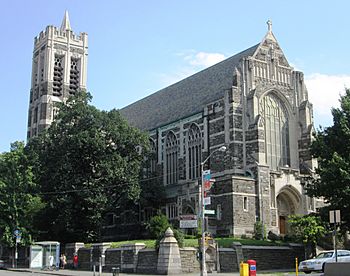Church of the Intercession (Manhattan) facts for kids
|
Chapel of the Intercession Complex
|
|

Looking southeast in 2013
|
|
| Lua error in Module:Location_map at line 420: attempt to index field 'wikibase' (a nil value). | |
| Location | 550 West 155th Street Manhattan, New York City |
|---|---|
| Built | 1912–1915 |
| Architect | Bertram Grosvenor Goodhue |
| Architectural style | church: Late English Gothic Revival, and others vicarage: Tudor Revival |
| NRHP reference No. | 80002677 |
Quick facts for kids Significant dates |
|
| Added to NRHP | July 24, 1980 |
The Church of the Intercession is an Episcopal church located in Manhattan, New York City. It stands at 550 West 155th Street and Broadway. This area is where the Harlem and Washington Heights neighborhoods meet. The church is built on the grounds of Trinity Church Cemetery.
The church community started in 1846. The building you see today was constructed between 1912 and 1915. It was designed by Bertram Grosvenor Goodhue in the Gothic Revival style. From 1906 to 1976, it was a special chapel of Trinity Church.
The Church of the Intercession and its nearby vicarage (a house for the priest) are important buildings. They were named New York City Landmarks in 1966. The whole complex was added to the National Register of Historic Places in 1980.
Contents
History of the Church
How the Church Started
The group that became the Church of the Intercession began in 1846. It was in a small village called Carmansville. This area is now part of the Washington Heights neighborhood. Famous artist John James Audubon and John R. Morewood helped start the church. The church officially became a group in 1847.
At first, church services were held in John R. Morewood's home. People who attended came from two other churches. Some were from Trinity Church downtown. Others came from the Church of the Ascension.
Early Church Buildings
In 1847, the church finished building its first home. It was a wooden church in the Victorian Gothic style. This building was located at West 154th Street and what is now Amsterdam Avenue. You can still see the shape of this old building on the side of the building next to it. In 1871, the church leaders decided to move and sell this first building.
The next church building was made of stone. It was designed by Rembrandt Lockwood. This church was at 158th Street and Broadway. However, there were disagreements among the church members. This caused money problems for the church. It became unable to pay its bills. The sheriff even took control of the church for a time. Services could only happen with special permission.
A New Beginning
Eventually, the church group got their building back. But by 1906, the church was too small for everyone. The church also still had debts. To solve these problems, they made a deal with Trinity Church. Trinity Church wanted to build a chapel on its cemetery grounds. So, the Church of the Intercession became a chapel of Trinity Church. It was called the Chapel of the Intercession.
The first stone for the new church building was placed in 1912. The building was officially opened in 1915. The architect, Bertram Grosvenor Goodhue, was very skilled in the Gothic Revival style. Many people think this church is his best work. Goodhue added parts from other styles too. For example, the tall, narrow entrances look like the English Perpendicular style. The pointed windows show the Decorated Period style. The church tower looks like the Tudor style. Edward A. Wehr, from Pittsburgh, built the church. He also thought it was his best project.
The church became an independent parish again in 1976.
Interesting Facts About the Church
- David Hurd was once the church's organist (the person who plays the organ). He wrote a special music piece called the Intercession Mass. Many Episcopal churches still use this music today.
- The church is famous for its yearly Clement Clarke Moore Festival. This is the oldest Christmas tradition that still happens in New York City. It takes place on the Sunday before Christmas at 4 PM. In 2010, they celebrated the 100th anniversary of this tradition. During the service, someone reads Clement Clarke Moore's famous poem, "A Visit from Saint Nicholas".
- Many important people are buried in the nearby Trinity Church Cemetery. This includes Clement Clarke Moore himself. There is also a large monument for John James Audubon. Other famous people buried here include John Jacob Astor and Alfred Tennyson Dickens. Alfred was the son of the famous writer Charles Dickens. The architect of the church, Bertram Grosvenor Goodhue, is also buried here. His friend Lee Lawrie sculpted a monument for him in 1929.
Interesting Facts About the Church
The Church of the Intercession has some unique features and traditions.
- David Hurd is a composer who used to be the church's organist. He wrote a special piece of music called the Intercession Mass. Many Episcopal churches still use this music today.
- The church is famous for its yearly Clement Clarke Moore Festival. This is the oldest Christmas tradition that still happens in New York City. It takes place on the Sunday before Christmas at 4 PM. In 2010, they celebrated the 100th anniversary of this tradition! The main part of the service is reading Moore's famous poem, "A Visit from Saint Nicholas" (also known as "Twas the Night Before Christmas").
- Many important people are buried in the nearby Trinity Church Cemetery. This includes Clement Clarke Moore himself. John James Audubon, who helped start the church, also has a large monument there. Other famous people buried here are John Jacob Astor and Alfred Tennyson Dickens. Alfred was the son of the famous writer Charles Dickens. The architect of the church, Bertram Grosvenor Goodhue, is also buried in the cemetery. His friend Lee Lawrie sculpted his tomb in 1929.
See also

